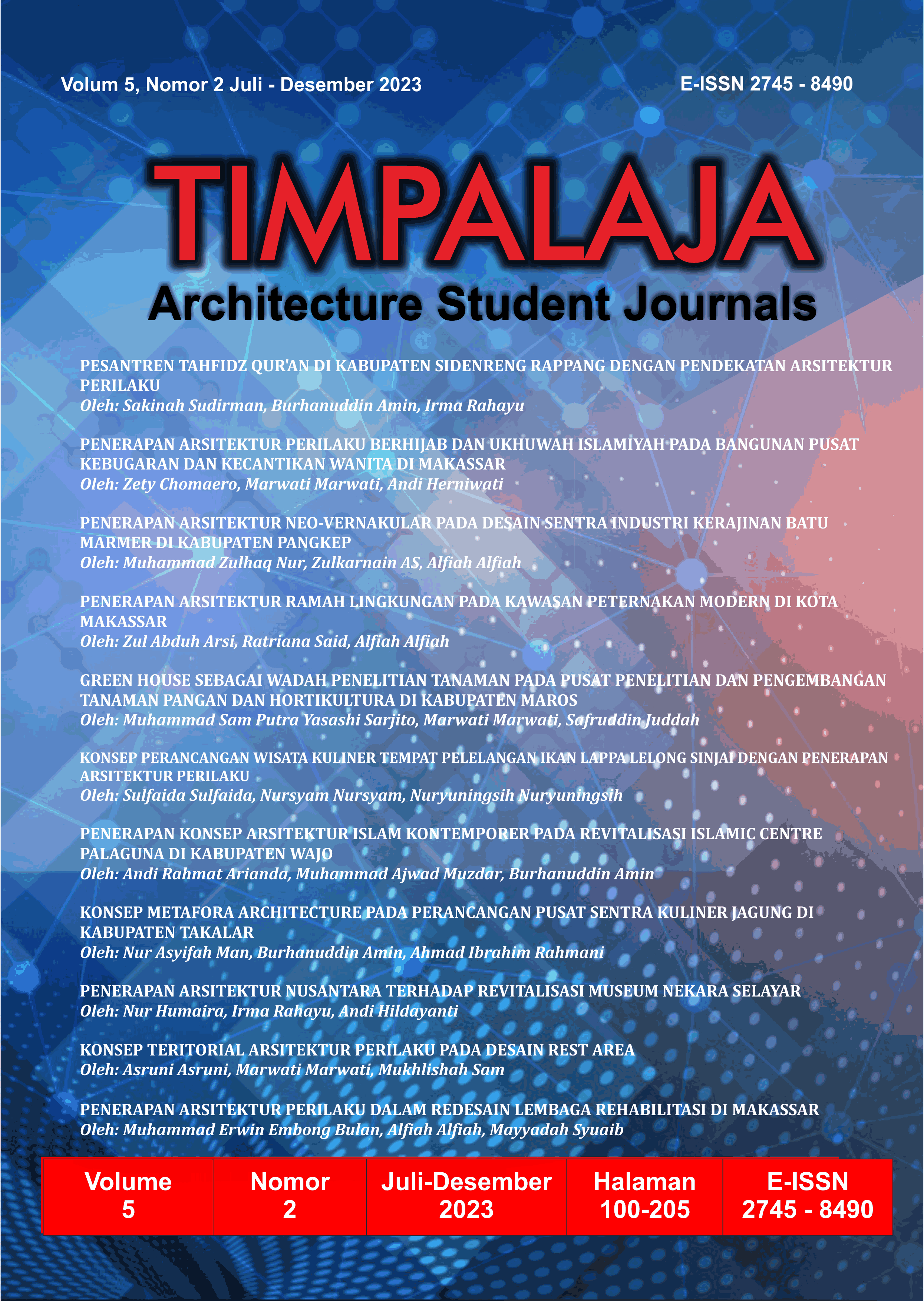Konsep Teritorial Arsitektur Perilaku Pada Desain Rest Area
Abstract
The construction of a rest area is essential to provide a comfortable resting place for drivers when they experience fatigue and decreased body endurance, according to Law Number 22 of 2009. This writing aims to obtain the results of designing a rest area using a behavioral approach. The discussion method begins with data collection, which is processed through field surveys by collecting physical/location data information according to the needs of the design concept approach. Then, function and approach and collect precedent studies. After the data collection method, a literature study was carried out in the form of theoretical data collection/standardization of data estimates. Data analysis was carried out using descriptive, synthetic, and exploratory methods. The research results obtained a territorial design concept in the rest and eating areas, which were grouped based on visitor characteristics. The idea of territory is applied to function as an area divider to provide comfort to its users. In using the concept of territory, three forming elements are needed. Namely, fixed elements, where these elements cannot be shifted or moved easily by the user; semi-fixed elements, where these elements are semi-fixed and can be turned or transferred at any time; and non-fixed elements are free elements is space resulting from change, this element is more related to humans as users of space, for example the movements and gestures of the human body..
References
Ayu Intan Putri, N. K. (2019). Faktor-Faktor Pembentuk Teritorialitas Di Permukiman Kampung Jawakota Denpasar. Jurnal Sangkareang Mataram, 5(3), 32–40.
Brower, S. N. (1980). Territory in Urban Settings. Environment and Culture, 179–207. https://doi.org/10.1007/978-1-4899-0451-5_6
Burhanuddin, burhannudin. (2010). Karakteristik Teritorialitas Ruang. Jurnal Ruang, 2(1), 39–46. http://jurnal.untad.ac.id/jurnal/index.php/RUANG/article/view/709
Departemen Pekerjaan, U. (1999). Tata cara penentuan lokasi tempat istirahat di jalan bebas hambatan. 037.
Dewi Nur’aini, R., & Ikaputra, I. (2019). Teritorialitas Dalam Tinjauan Ilmu Arsitektur. INERSIA: LNformasi Dan Ekspose Hasil Riset Teknik SIpil Dan Arsitektur, 15(1), 12–22. https://doi.org/10.21831/inersia.v15i1.24860
Lukman, M. Y., Zaki, M., & H Rako, E. (2019). Perencanaan Rest Area Dengan Konsep Michi-No Eki Di Jalur Non-Tol (Studi Kasus: Kabupaten Barru, Provinsi Sulawesi Selatan). Losari : Jurnal Arsitektur Kota Dan Pemukiman, 67–76. https://doi.org/10.33096/losari.v4i2.73
Marlina, H., & Ariska, D. (2019). Arsitektur Perilaku. Jurnal Rumoh, Vol. 9(No. 18), 47–49.
Said, M. N., & Natalia, D. A. R. (2020). Perancangan Rest Area Tipe – A di Jalan Tol Ngawi – Kertosono. Seminar Ilmiah Arsitektur, 8686, 538–543.
Sativa, Setiawan, B., Wijono, D., & Adiyanti. (2017). Variasi Seting Fisik Ruang Interaksi Anak Di Kampung Padat Kota Yogyakarta. Variasi Seting Fisik Ruang Interaksi Anak Di Kampung Padat Kota Yogyakarta, 13(2), 167–177.
Yoyok Agustina, Ari Widyati Purwantiasning, & Lutfi Prayogi. (2018). Penerapan Konsep Arsitektur Perilaku Pada Penataan Kawasan Zona 4 Pekojan Kota Tua Jakarta. Jurnal Arsitektur PURWARUPA, 2(2), 83–92.
Copyright (c) 2023 Asruni Asruni, Marwati Marwati, Mukhlishah Sam

This work is licensed under a Creative Commons Attribution-ShareAlike 4.0 International License.
By submitting your manuscript to our journal, you are following Copyright and License







